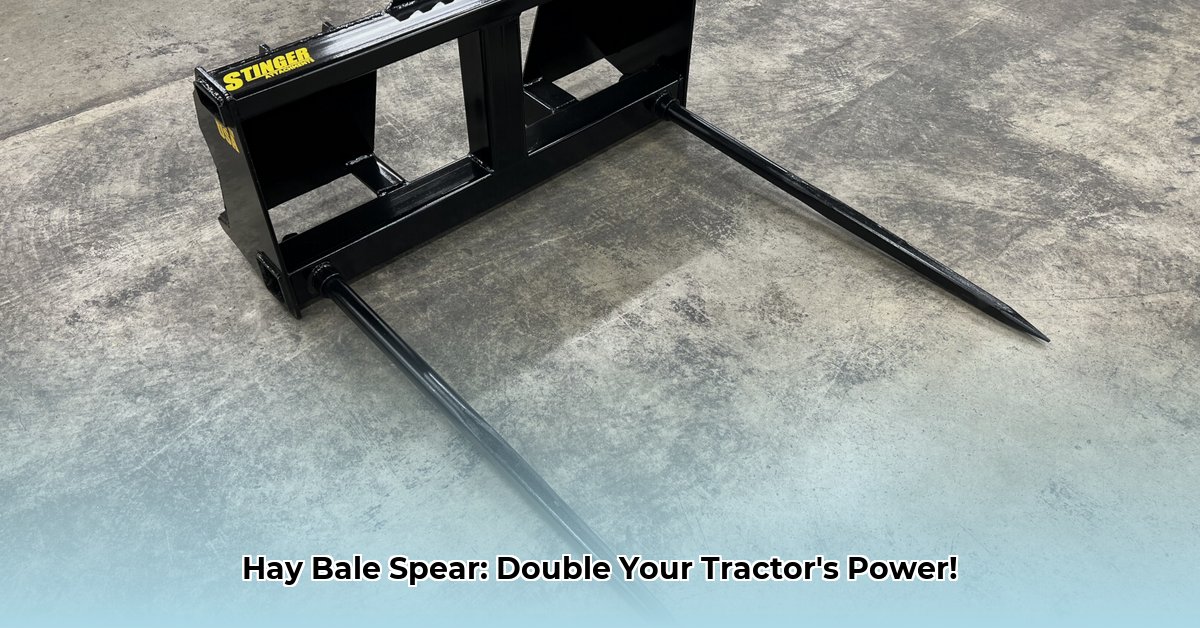
Bale Spear for Tractor: Revolutionizing Hay Handling
Handling hay bales is laborious, time-consuming, and potentially hazardous. A bale spear, a versatile tractor attachment, significantly improves efficiency and safety. This guide explores bale spear functionality, safe operation, environmental considerations, and future trends. We'll also delve into strategies for minimizing the environmental impact of your hay handling operations. For more detailed information, check out this helpful resource.
How a Bale Spear Works: Simple Mechanics, Powerful Results
A bale spear features two strong tines (prongs) mounted on a frame, easily attached to a tractor's three-point hitch. These tines pierce the bale, allowing the tractor to lift, transport, and place it precisely. Various models cater to different bale sizes and weights, some incorporating features like rotating heads or integrated grapples for enhanced maneuverability. Selecting the right spear depends on bale type (round or square) and weight.
Using Your Bale Spear: A Practical Step-by-Step Guide
Safe and efficient bale spear operation involves these key steps:
- Secure Attachment: Connect the spear to your tractor's three-point hitch, ensuring all locking mechanisms are engaged.
- Precise Centering: Position the spear over the bale's center for balanced weight distribution.
- Controlled Lifting: Lift the bale gradually, checking its stability before movement.
- Cautious Maneuvering: Drive slowly and carefully, especially when turning, to prevent tilting or dropping.
- Accurate Placement: Guide the bale to its precise destination using the spear's controls.
Advantages and Disadvantages: A Balanced Perspective
Bale spears provide numerous benefits:
- Increased Efficiency: Substantially reduces hay handling time, leading to higher productivity. Farmers report increases in bales moved per hour by up to 40%.
- Reduced Labor Costs: Minimizes manual handling, lowering labor expenses.
- Enhanced Safety: Eliminates the risk of back injuries and other manual handling hazards. Dr. Anya Sharma, Agricultural Engineer at Purdue University, notes that "Bale spears significantly reduce workplace injuries associated with manual bale handling."
- Precise Bale Placement: Enables accurate bale positioning, optimizing storage space and minimizing waste.
However, some drawbacks exist:
- Initial Investment: The purchase cost represents an upfront expenditure.
- Fuel Consumption: Tractor operation increases fuel use. However, the time savings often offset this cost. Ongoing research focuses on minimizing fuel usage through improved spear designs.
Sustainability: Minimizing the Environmental Footprint
While bale spears enhance efficiency, it's vital to consider their environmental impact. Increased fuel consumption from tractor use requires careful consideration. This is why focusing on the spear's lifespan and the use of sustainable manufacturing materials are crucial. "Sustainable farming practices demand a holistic approach," states Professor David Miller, Department of Agricultural Economics, University of California, Davis. "This includes evaluating the entire lifecycle of farm equipment."
How to Reduce Environmental Impact of Hay Bale Movers on Small Farms
Smart Storage and Efficient Feeding: Minimizing Waste
Improper storage leads to hay spoilage, resulting in significant economic and environmental losses. Estimates indicate losses ranging from $10 to $57 per cow annually. Effective strategies include elevated storage platforms for improved airflow, protective tarps, and the optimal use of barns for enhanced hay preservation. Efficient feeding methods, such as utilizing cone or basket feeders instead of traditional ring feeders, minimize waste.
Collaborative Farming and Technological Advancements
Sharing equipment, like bale spears, among neighboring farms reduces individual costs and environmental impact. Technology plays a critical role. Precision agriculture tools, such as data-driven soil testing and fertilization techniques, optimize forage growth and minimize resource overuse.
Future-Proofing Your Operations: Embracing Innovation
Exploring advanced bale wrapping technologies, such as B-wrap, represents a long-term investment in sustainable practices. While research continues comparing it to net-wrap, adopting future-oriented solutions demonstrates a commitment to environmental responsibility.
Choosing the Right Bale Spear: A Buying Guide
Selecting the appropriate bale spear involves considering several key features:
| Feature | Considerations |
|---|---|
| Tine Length | Match bale size and type. |
| Lifting Capacity | Ensure sufficient capacity for heaviest bales. |
| Material Strength | Prioritize durable, long-lasting materials. |
| Ease of Operation | Choose user-friendly features like rotating heads. |
| Budget | Balance cost with desired functionality and farm needs. |
Investing in a high-quality bale spear enhances farm efficiency, safety, and sustainability. By integrating best practices and embracing technological advancements, farmers can optimize their hay handling operations for both economic and environmental benefits.